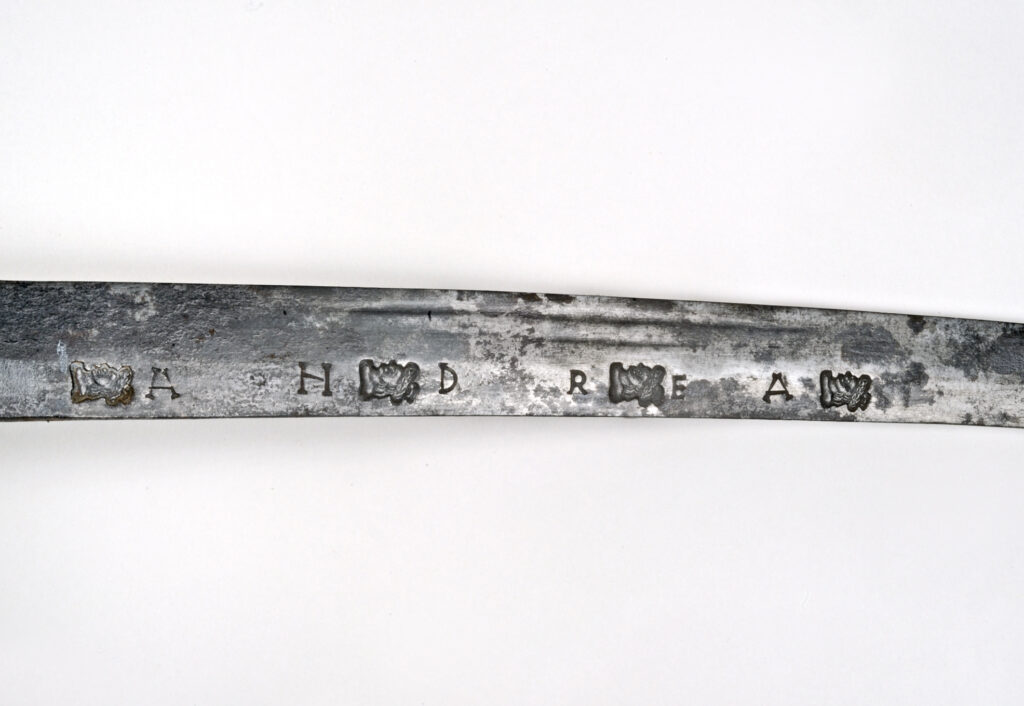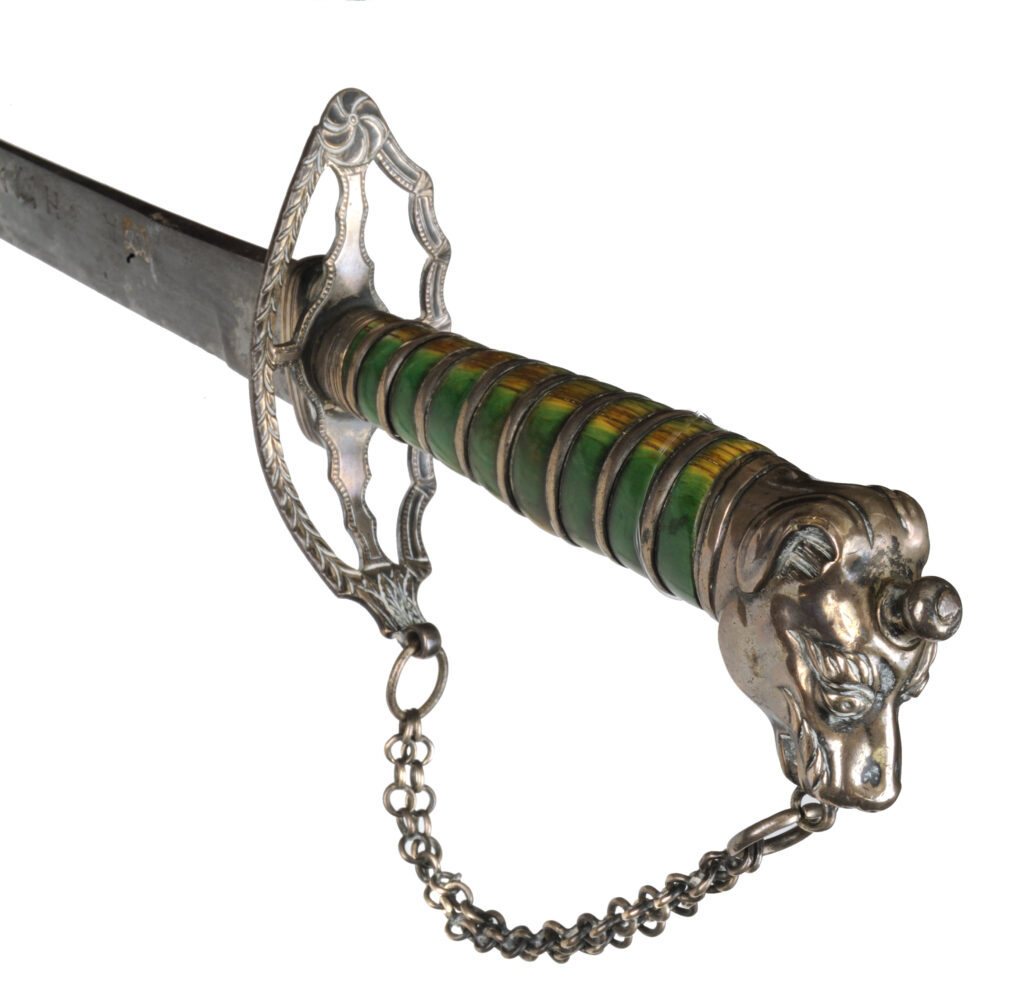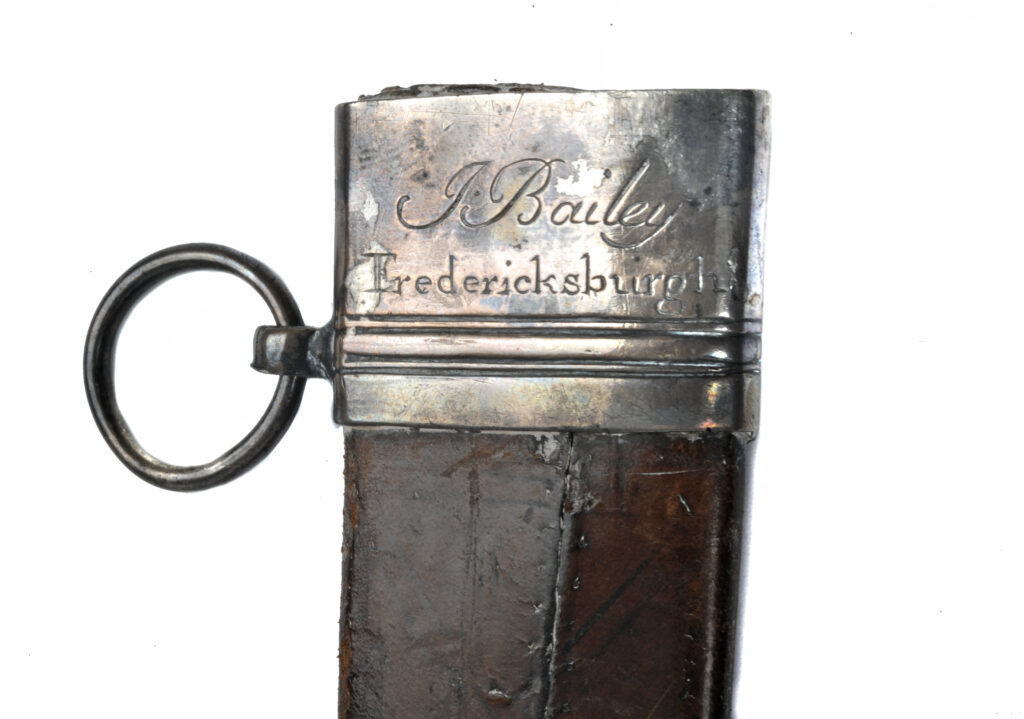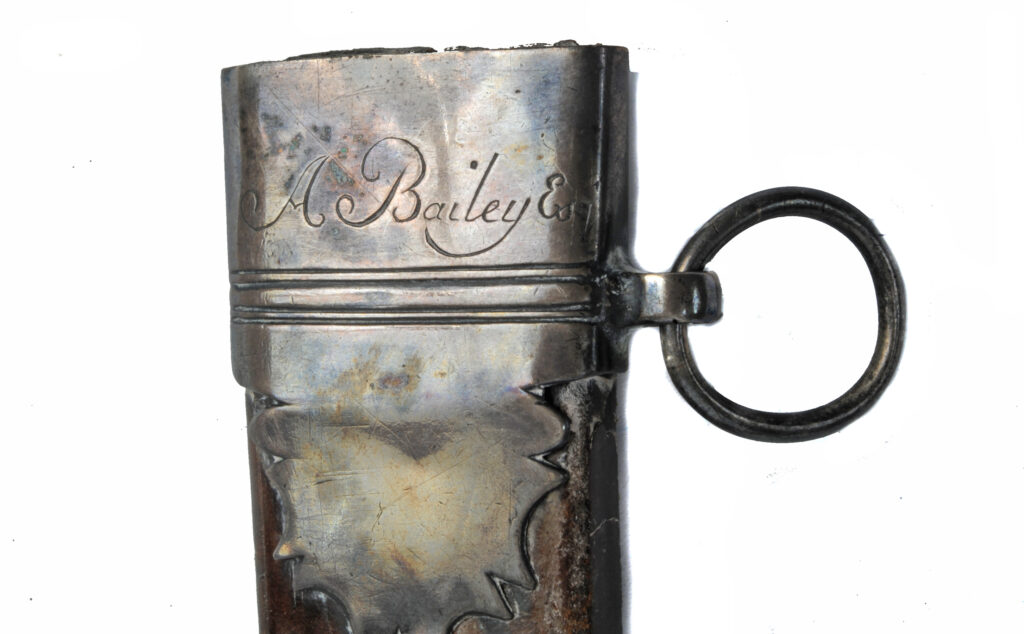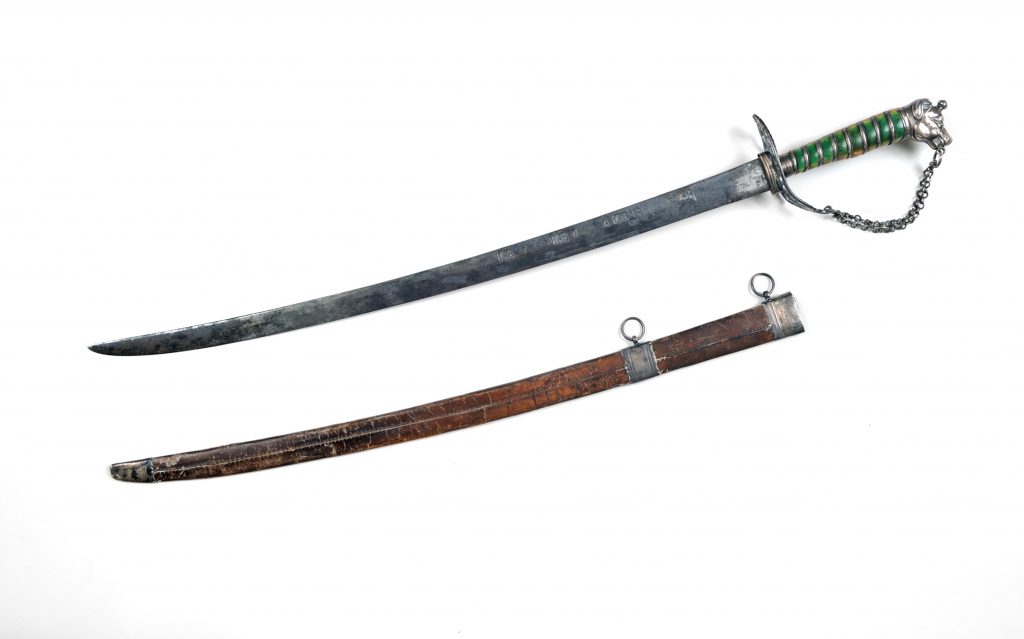
This Revolutionary War cuttoe, or hanger, was made by John Bailey in Fredericksburgh, New York, ca. 1778, and was carried by Adams Bailey of the Second Massachusetts Regiment. The sword retains its original leather scabbard.
Swords have been integral to warfare for millennia, both for their practical use as weapons and the meaning that people have derived from them as status symbols. One of the finest swords in the Institute’s collections is the Adams Bailey sword. It was made by renowned cutler John Bailey in Fredericksburgh (now Patterson), New York, ca. 1778, and owned by Adams Bailey (no relation), a captain in the Second Massachusetts Regiment of the Continental Army and an original member of the Massachusetts Society of the Cincinnati. The sword is a fine example of the cuttoe style popular in the late eighteenth century, featuring fine decorative elements including a silver pommel in the shape of a dog’s head and a green stained ivory grip. With such fine decoration and yet functional in its form, the Adams Bailey cuttoe demonstrates the dual purposes of an eighteenth-century American officer’s sword: to function on the battlefield and to affirm the status of its owner.
The Adams Bailey sword can be referred to as a cuttoe or hanger, both names originating from the form’s use as a European hunting weapon in the seventeenth century. The name “cuttoe” is an anglicization of the French term couteaux de chasse, meaning “hunting knife.” In the late seventeenth and early eighteenth century, hangers became popular secondary weapons for infantrymen in many of the armies of Europe. The length of hanger blades is typically between 24 and 27 inches—much shorter when compared to the small swords used by many officers in the armies of Britain and France that typically have a blade length of between 30 and 33 inches. With its hunting pedigree and the weapons’ smaller stature, hangers and cuttoes found favor with some gentlemen of France, Britain and the North American colonies in the eighteenth century. To assist in proclaiming their owner’s status, these former hunting sidearms became ornately adorned with silver decoration, fine knuckle chains and decorative grips.
The Adams Bailey sword has a total length of 27 ¾ inches. The blade is 21 ½ inches long with a width of 1 1/16 inches at the shoulder. The right face of the blade is marked “ANDREA” and the other side “FARARA”—both words interspersed with bust-length profiles of a stylized “eastern” figured dressed in a turban. Andrea Farara (also spelled Ferrara or Ferrara), of whom little is known, is thought to have been either a Spanish or Italian sword maker working in the seventeenth century. His blades were held in such high regard that other makers marked their blades with his name, whether as an attempt at forgery or as a statement as to the quality of their own blades.
The hilt is comprised of a silver asymmetrical counterguard with a double knuckle chain fastened by suspension rings to the finely fashioned silver dog’s head pommel. The grip consists of ivory that was stained green and entwined with a silver band. The slightly curved blade is single edged with a 4 ½ inch false edge, terminating in an asymmetrical point on the inward curve. Remnants of a double fuller are just visible on the center of both faces of the blade. The matching silver-mounted leather scabbard features on one face of the throat piece, “J Bailey / Fredericksburgh” (the maker), and on the other side, “A Bailey Esq” (the owner).
Born ca. 1736, John Bailey hailed from Yorkshire, England. After serving an apprenticeship in Sheffield, Bailey, at the age of nineteen, emigrated to New York City in 1755. By March 1771, Bailey had partnered with fellow Sheffield cutler John Youle to form Bailey & Youle, with premises located near the city’s Merchant’s Coffee House. Not only did the pair sell swords, but “surgeons instruments, trusses, steel collars for children… and silversmiths tools.” A short four years later, in August 1775, war came to New York when the British warship HMS Asia bombarded the town to dissuade the relocation of cannon from Fort George. In response, Bailey, now married, relocated to a farm along the Hudson River. In subsequent years, Bailey would move at least three more times, as illustrated by the town names Verplanck’s Point, Fredericksburgh and Fishkill that are engraved beside his name on extant swords. Fortunately for Bailey, after the British capture of New York City in the fall of 1776, the Continental Army established an armory and depot in Fishkill, bringing Bailey a concentrated potential customer base. In his May 3, 1864, paper, Issac Greenwood stated that Bailey, when operating out of Fishkill, produced “two dozen good and useful weapons [and] were frequently finished in the course of a week.” If Greenwood’s statement is true, Bailey must have had assistants, and based on the evidence of the extant swords signed by Bailey, must have been producing examples of a less ornate and practical design. Not much else about how many swords Bailey made and who his clients were is known.
After the war, John Bailey returned to New York City, where in 1794 he began a partnership with G. Hedderly operating a bell foundry. Bailey died on January 22, 1815, and he was followed in business by his son, James. Today, John Bailey is most known for the several finely decorated swords that survive him. The most famed of these is the so-called “battle sword” owned by George Washington and likely purchased when Bailey was at Fishkill. Painter Charles Wilson Peale, in his 1779 full-length portrait entitled George Washington at Princeton, depicts a triumphal Washington, with the hilt of the general’s Bailey-made sword just visible. Washington’s Bailey-made sword—also featuring a green stained ivory grip—is in the collections of the Smithsonian Institution’s National Museum of American History.
The Bailey-made cuttoe in the American Revolution Institute’s collections was originally owned by Adams Bailey. Born on January 16, 1748, in Scituate, Massachusetts, as the son of Adams and Sarah (née Howard) Bailey, the younger Adams saw action at Lexington on April 19, 1775, as a sergeant. In May 1775, Bailey was made a quartermaster in Thomas’ Massachusetts Regiment before receiving a commission on January 1, 1776, in the newly renumbered Twenty-third Continental Infantry. On January 1, 1777, Bailey was promoted to first lieutenant and made paymaster of the regiment (now numbered the Second Massachusetts), and captain on November 1, 1778, serving through to November 3, 1783.
The Second Massachusetts had a storied career during the Revolutionary War, serving first during the Siege of Boston in the spring of 1775, then at the Battle of Long Island in 1776, the Saratoga campaign of the fall of 1777, and the Valley Forge encampment for the winter of 1777-1778 before seeing out the rest of the war in Newburgh and West Point, New York.
Following the cessation of hostilities with Great Britain in 1783, Bailey returned to his civilian life as a famer in Scituate alongside his wife, Mary. He became an original member of the Massachusetts branch of the Society of the Cincinnati, later holding the offices of assistant treasurer and assistant secretary of the Massachusetts Society. In 1810, Adams Bailey moved to Charlestown (now Chelsea), Massachusetts, where he was manager of the U.S. Marine Hospital. He died a widower in Charlestown in 1824, leaving behind his son, Adams.
The cuttoe descended in the family to Captain Bailey’s great-great grandson, Dr. Adams Bailey, who generously donated the sword to the Society of the Cincinnati in 1964.
View More Armaments

Cuttoe and scabbard owned by Adams Bailey
John Bailey, Fredericksburgh, N.Y.
ca. 1778Gift of Dr. Adams Bailey, Massachusetts Society of the Cincinnati, 1964
This Revolutionary War cuttoe, or hanger, carried by Massachusetts officer Adams Bailey is one of the few swords made by New York cutler John Bailey to survive today—and does so with its original leather scabbard.